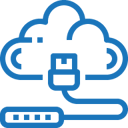Cloud eCommerce
Nowadays vendors tend to liberally use the the word “cloud” when they name and advertise their products. Names like “SAP Commerce Cloud”, “SAP Sales Cloud”, “Salesforce Sales Cloud”, “SAP Marketing Cloud”, “Salesforce Marketing Cloud”, “SAP Service Cloud”, “Adobe Experience Cloud” are all signs of a recent trend in enterprise software – transition from on-premise to cloud offerings.
The term “cloud” means something different to different people, so here is a quick primer on how the term “cloud” is mostly used in relation to SAP eCommerce. Most software solutions can be grouped based on:
1. Who owns and manages the hardware the solution runs on?
2. Who owns and manages the software itself? (e.g. perpetual license vs. subscription)
Here are the possibilities:
| Hardware Ownership | Software Ownership | Model |
| own | own | On-premise |
| rent machines (e.g. from Amazon/Google/Microsoft) | own | Public/Private cloud |
| rent from vendor (e.g. from SAP or Salesforce) | rent from vendor (e.g.SAP or Salesforce) | Vendor Cloud |
Here is a quick example an how this may work using Hybris (the eCommerce platform that underlines SAP eCommerce solution) in a case of sample, made-up company “Best Goods International” (BGI):

On Premise Model: BGI purchases Hybris from SAP and builds eCommerce solution that it runs it in its own data center. BGI owns the Hybris license and pays maintenance fees. BGI owns the hardware, and BGI IT team installs, manages and configures Hybris. BGI is also responsible to plan for any extra capacity they may need to handle their holiday traffic. BGI staff needs to be able to upgrade and patch Hybris itself, the machines Hybris runs on (e.g. Install Windows/Linux patches) and fix any hardware and network issues.
The main benefit of this model is that BGI engineers can fine tune any aspect of the final solution – from networking to machine hardware to squeeze as much as possible from their hardware and software investment. They can also customize Hybris in any way they want to fit their business. Downside is that BGI needs to have engineers with a wide range of skills to support all the moving parts in a complex eCommerce system 24/7. This model is mostly used by large, companies that already have (..or can pay for) all that skills, expertise and infrastructure.

Public/Private Cloud Model: BGI purchases Hybris license from SAP and builds eCommerce solution. They still pay for Hybris license and maintenance, but rather than running it on BGI’s owned hardware, they rent the hardware from a cloud data center owned by Amazon, Google or Microsoft (or multitude of other cloud providers) . BGI is still responsible to install, manage and configure Hybris itself, as well as patch the machines Hybris runs on (e.g. Install Windows/Linux patches), but it does not need to worry about fixing or upgrading the hardware or network connectivity. Also, the hardware cloud provider will willingly (and temporarily) rent more machines when they need extra capacity during the holiday season. BGI can fine tune their Hybris install but is at the mercy of the Cloud provider for every networking or hardware outage they encounter.

Vendor Cloud Model: BGI rents Hybris (in this case called SAP Commerce Cloud) from SAP. SAP will “rent” both the software as well as the hardware. The final solution will run in SAP cloud Platform in a data center managed by SAP. SAP will be responsible to manage and scale the entire solution. This model outsources most of the day-to-day management of the eCommerce system to the cloud vendor using “pay-per-use” model.
The disadvantage of this model is that, similar to a rental house, there are certain constrains that the “landlord” (cloud vendor) imposes on what customizations tenants can do to their rented Hybris installations (because they need to support the overall system). If you are interested to learn more about SAP Cloud, quick overview of SAP Cloud can be found in our SAP Cloud Platform: A High-Level Overview blog post.
Historically the trend has been to move from On-Premise towards Vendor Cloud. Vendor cloud is where most vendors want to eventually migrate to as it generates a recurring revenue and they can optimize their investment in hardware and operations to service more customers with less resources (which increases their profit margin).
Vendor Cloud is also a good solution for many small and medium size customers as it lowers the barrier of entry. They can now “rent” an enterprise grade eCommerce system without the need for a large initial investment. This also aligns the cost for running the eCommerce system with the revenues generated by their eCommerce channel. This alignment is a key for many smaller companies who are transitioning from traditional “phone/fax” sales to an online sales model and want their eCommerce revenues to offset their eCommerce expenses. As of now, the industry is split roughly 50%-40%-10% across the three models.
Want to learn more about SAP eCommerce? Check out our Ultimate Guide to eCommerce.



